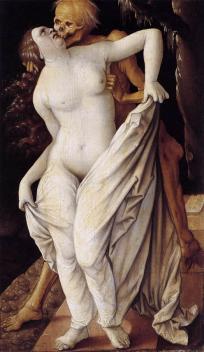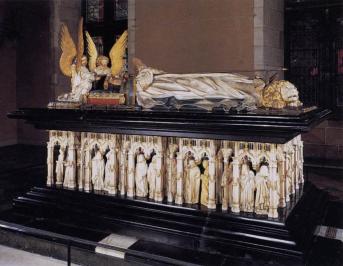1) Pieter Bruegel the Elder,The Triumph of Death, c. 1562, Oil on panel, 117 x 162 cm, Museo del Prado, Madrid.
2) Unidentified French Miniaturist, Judgment of the Dead, c. 1418, Vellum, 25,4 x 17.8 cm, Bibliothèque Nationale, Paris.
3) Hans Memling, Last Judgment Triptych (open), 1467-71, Oil on wood, 221 x 161 cm (central), 223,5 x 72,5 cm (each wing), Muzeum Narodowe, Gdansk.
4) Konrad Witz, St Christopher, Saint Christopher, c. 1435, Panel, 101 x 81 cm, Öffentliche Kunstsammlung, Basel.
5) Hieronymus Bosch, Death and the Miser, c. 1490, Oil on wood, 93 x 31 cm, National Gallery of Art, Washington.
6) Unknown Netherlandish Artist, Ars Moriendi, (The Art of Dying), woodblock, about 1460.
7) Hieronymus Bosch, study for Death and the Miser, Washington, Drawing, 256 x 149 mm, Musée du Louvre, Paris.
8) Guyot Marchand, Danse Macabre, 1485, woodcuts.
9) Unknown artist, Church of the Holy Innocents, Paris, est 12th cent; closed 1780, 1550, watercolour, dimensions and location unknown.
10) Unknown artist, Charnel House, Charnel house with mural of the Danse Macabre.
11) Unknown Artist, The Dance of Death, stage 1, probably 1460, fresco, Abbey of La Chaise-Dieuen Haute-Loire.
12) Unknown Artist, The Dance of Death, stage 3, probably 1460s, fresco, Abbey of La Chaise-Dieuen Haute-Loire.
13) Bernt Notke, Fragment of the Danse Macabre, around 1463, fresco, originally 30 metres, Church of Saint-Nicolas, Tallinn, Estonia.
14) Bernt Notke, Original Danse Macabre before Allied Bombing of Lübeck in 1942.
15) Hans Holbein the Younger, The Plowman from Dance of Death, 1524-26, Woodcut, 65 x 48 mm, Kupferstichkabinett, Öffentliche Kunstsammlung, Basel.
16) Hans Holbein the Younger, The Rich Man; The Queen, 1523-26, Woodcut, 64 x 48 mm, National Gallery of Art, Washington
17) Hans Holbein the Younger The Noble Lady from Dance of Death, 1524-26, Woodcut, 65 x 48 mm, Kupferstichkabinett, Öffentliche Kunstsammlung, Basel
18) Hans Holbein the Younger, Todesalphabet or Alphabet with Dance of Death, c. 1524, single leaf woodcut with type printing, 27 x 34, Kunstsammlung der Veste, Coburg.
19) Hans Baldung Grien, Adam and Eve, 1531, Oil on panel, 148 x 67 cm, Museo Thyssen-Bornemisza, Madrid.
20) Hans Baldung Grien, The Knight, the Young Girl, and Death, c. 1505, Oil on wood, 355 x 296 cm, Musée du Louvre, Paris
21) Albrecht Dürer, Knight, Death and the Devil, 1513, Engraving, 245 x 188 mm, Staatliche Kunsthalle, Karlsruhe.
22) Hans Baldung Grien, Death and the Maiden, 1518-20, Oil on panel, 31 x 19 cm, Öffentliche Kunstsammlung, Basel.
23) Hans Baldung Grien, Death and the Maiden, 1517, Oil on panel, 30 x 15 cm, Öffentliche Kunstsammlung, Basel.
24) Albert van Ouwater, The Raising of Lazarus, c. 1455, Oil on wood, 122 x 92 cm, Staatliche Museen, Berlin.
25) Claus Sluter, Stone, Charterhouse of Champmol, Dijon, 1389-1406, Memorial to Philip the Bold, Philip the Bold introduced to the Virgin.
26) After Jean Malouel, Philip the Bold, 1500s, Panel painting, Musée National, Versailles.
27) Claus Sluter, Memorial to Philip the Bold Margaret of Flanders, the wife of Philip the Bold.
28) Claus Sluter, Tomb of Philip the Bold, Duke of Burgundy, 1390-1406, Alabaster, height 243 cm, Musée Archéologique, Dijon.
29) Claus Sluter, Tomb of Philip the Bold, Duke of Burgundy, 1390-1406, Alabaster, height 243 cm, Musée Archéologique, Dijon, different view.
Link for images.



